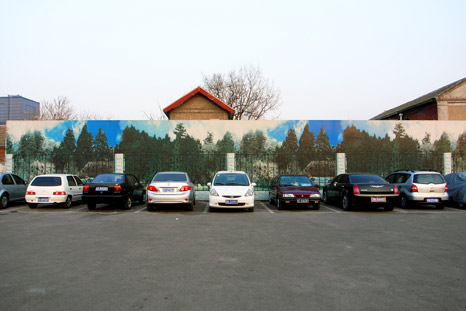Below is an excerpt from an essay by curator/critic Steven L. Bridges concerning contemporary practices in art in the public sphere. Let’s hope this doesn’t sound too pretentious, but sometimes you feel like someone knows exactly what you’re going through… (and they’re a lot more well-versed at it than you are) Thank you to Doug Lewis, for indirectly leading me to it. The full essay can be found here.
 photo from me, February 2010
photo from me, February 2010
The current climate surrounding contemporary art production—including recent curatorial and exhibition practices—is especially marked by an ongoing expansion of the field across disciplinary boundaries and beyond the conventional spaces of display and reception. This expanding field of artistic production spreads in multiple directions, an expanding universe without any definite center or edge. One facet of this expanding field concerns the arm of contemporary art production today that takes the very nature of human relations as the source material for the undertaking of a project or research initiative. In doing so, artistic processes are combined with social processes of transformation through the “making visible” of that which is otherwise invisible: that is, the very socio-politico-economic tensions and power relations that organize societal life, as well as the “invisible” people within society, the marginalized and/or disenfranchised.
Many projects of socially engaged, collaborative art are highly complex systems that entangle both aesthetic and socio-politico-economic issues. These kinds of practices often speak to diverse groupings of people, who—while deeply interconnected—may or may not have access to the necessary socially, culturally or politically viable opportunities for the articulation of their personal views and concerns, their own subject positions. This type of working process—layering aesthetic and sociopolitical issues; employing open-ended, dialogical modes of production; testing the very publicness of the spaces in which the work permeates—requires a kind of artistic and curatorial prowess that focuses on notions of collaboration, representation and improvisation. Yet, the very mutability of these practices does much to dissuade the use of oversimplified categories and concepts, and without sufficient tools (theoretical or practical) to measure and gage their multiple values and points of reception, analysis can often lead to a reduction of the works to a single dimension or create a misleadingly narrow critical framework.
In order to avoid the numbing effects that accompany the use of generic terms—the pitfalls of overgeneralization—I will take a moment to further explore the concepts of collaboration and representation in the hopes of reactivating them within the context of this analysis. My interest in collaborative processes extends far beyond merely the definition of two or more people “working together.” This is a rather mundane interpretation and does not convey the sense of reciprocal activation—processes that create a sense of agency and empowerment among the participants that they may not otherwise put into practice—that is fundamental to collaboration. The exhibitions, and works of art within, develop situations for the expression of multiple subject positions, and it is through these kinds of exchanges that the possibility for change is enacted, with careful attention paid to the aesthetic potential of the communicative act. Above all, these projects come to function as critical sites of debate and contestation, a form of productive interaction that invariably metabolizes the different viewpoints of those involved in order to produce other viewpoints to be mulled over and debated. Such processes are ultimately dialectical in nature, productive in their sustained oppositionality and interconnectedness.
—
Read the rest of “Making the Invisible Visible: A City in Multiples and the Art of Multiplicity“.

 时间 posted on: 23 February 2010 |
时间 posted on: 23 February 2010 |  发布者 author:
发布者 author: 
 分类 filed under:
分类 filed under: